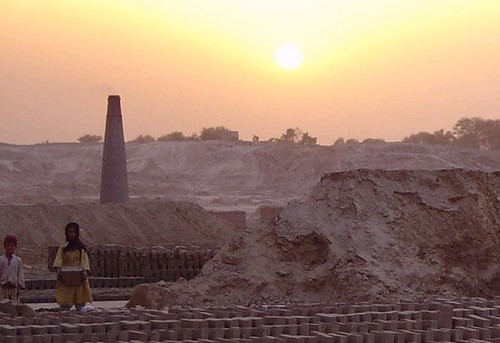 Brick making is a valuable industry to Pakistan – indigeneous and providing employment in rural areas where agriculture may not be enough to sustain all the people.
Brick making is a valuable industry to Pakistan – indigeneous and providing employment in rural areas where agriculture may not be enough to sustain all the people.
I met today with a German consultant today who has visited Pakistan several times to help local industry improve their brick-makng processes. My meeting encouraged me to learn a bit more about this industry, and how Pakistan fared in it.
I wasn’t surprised to learn we had a large brick industry, but I was horrified to read the work/living conditions of labor that was employed in these brick kilns (bhattis). These photographs depict the difficult lives of labor in this neglected industry, but also highlight how application of new technologies and mechanization can be useful.
Many brick factories today are built in extremely rural areas, and often employ the poorest (and most vulnerable) people from our society. Afghan refugees, for example, easily find employment in brick kilns since they are more willing to work under the gruesome conditions in the field than to return back to the troubles in their own country. As such, it has become more common to see a worseing of the work conditions, where long hours in the sun at temperatures exceeding 40 celsius would only result in daily average pays of 50-75 cents per day. The Pakistan Bhatta Mazdoor Union (PBMU) alleges that conditions for the 1.8 million people employed by this industry resemble slavery, in part due to the advanced (peshgi) system that leads to bonded labor.
Child labor is a major issue for some Pakistani industries, and brick kilns are a good example of that. Children as young as 5 years old can be found employed at these factories. The income of the household, not being enough to feed the entire family, means that many children, who should be in school playing with other children their age, instead must go to the local brick factories and work long hours. They work all day, and sometimes into the night – for barely enough money to feed themselves and their siblings at home. It should be no surprise that young girls working at these factories are especially vulnerable, as incidents of abuse have sometimes become known. Something has to be done about it – whether it is through literacy programs, Karkhana schools or other public or private programmes. These children are our future and we are burning their future away with the coal in the firing kilns.
Brick chimneys bellowing out smoke visible frequently dot the rural landscape of Pakistan, and as a child I remember fondly looking at them during train rides from Karachi to Islamabad. Today, I can identify the smoke as not just pollution that affects the global environment, but as a direct and deadly health hazard to the lives of the people who inhabit areas close to the brick kilns. There are more than 450 brick kilns located around the city of Peshawar, and the impact on local pollution is truly incredible. Coal is often used to burn the bricks and the heavy smoke contains soot (fine carbonaceous particulates) that penetrate deep inside the lungs and can cause severe asthma, congestion, chronic lung diseases and even cancer. As with other hazards, the young children are particularly vulnerable to the sickness, disease, and mortality.
The consultant I met reminded me that the brick-making industry had advanced a lot in the past few decades. I hope Pakistan, through legislation, regulation and government assisted financing, can also implement some of the newer technologies. I learnt, for example, that by making minor modifications to drying process for the bricks – making a ventilated air-drying shelter from cheap local materials instead of drying bricks in the sun – he was able to reduce drying time from 4 months to 4 days for a brick kiln close to Peshawar. Similarly, clean coal technologies are now becoming available where both the coal is pre-treated for more complete combustion (less coal, and hence less cost, required per firing), and smoke is scavenged before it can leave the chimneys. Right next door to us, in India, much work is being done, especially by Development Alternative, and in improving brick-making industry and we may can learn a thing or two from them as well.
The list of to-do’s is long, but we need motivation for implementation. Technology can only help if the social impetus is there for its adoption. I was hoping the infectious smile of the kid in teh earlier photograph, and our concern for his and our nation’s future, would do it!
Dr. Bilal Zuberi is Vice President of Product Development at GEO2 Technologies in Boston (MA), USA. See more at Bilal’s blog: BZNotes.



















































Let us not be decieved by that chil’d smile. Beneath it lies much pain. And shame for all of us Pakistanis.
P.S. Mr. Zuberi, I am surprised that you were surprised to learn about the injustice that goes on in these klins. Where have you been as this tragedy has taken world stage!!